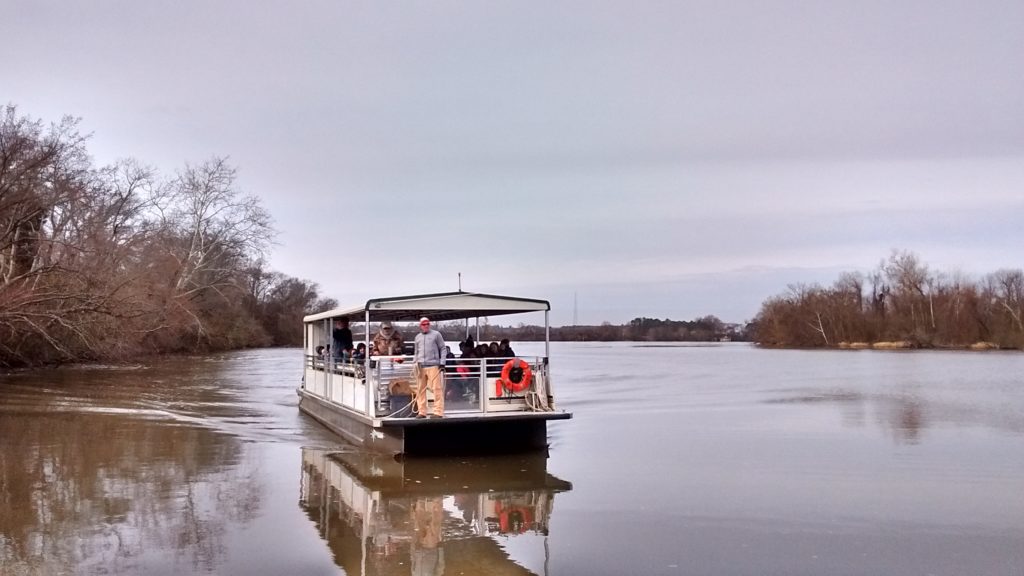The Great Return of the Atlantic Sturgeon
Atlantic Sturgeon
Acipenser oxyrinchus oxyrinchus
Regarded as a living fossil, the Atlantic sturgeon’s appearance has changed little since the age of dinosaurs. These remarkable fish can grow up to 14 feet long, weigh as much as 800 pounds, and live as long as 60 years. They spend their adult years in the Atlantic Ocean, then return each spring and fall to spawn in the rivers where they were born.
Commercial harvesting decimated the Atlantic sturgeon population in the late 1800s. Continued threats to the Atlantic sturgeon’s recovery include boat propellers, ship strikes, by-catch in commercial fisheries, and sediment pollution that blankets spawning habitat on the bottom of the river.
The U.S. Fish & Wildlife Service, Virginia Institute of Marine Science, National Oceanic and Atmospheric Administration, U.S. Army Corps of Engineers, Virginia Commonwealth University Rice Rivers Center, and James River Association began working together to restore a viable population of Atlantic sturgeon in Virginia’s James River in 2006. Since 2010 three experimental spawning reefs have been constructed in the James River downriver of Richmond in an attempt to restore the population of this incredible fish.

Sturgeon Sculpture Map
This story map celebrates the amazing Atlantic sturgeon as envisioned by three local artists. The story map highlights sturgeon sculptures along the Appomattox River, commissioned by CultureWorks to create public art for the community and raise awareness of FOLAR’s mission to conserve, protect, and promote the Appomattox River for all to enjoy. Check out the story map, check out the sculptures, and check out additional opportunities to celebrate sturgeon.
Facts About Atlantic Sturgeon
- Atlantic sturgeon can grow up to 14 feet in length, weigh up to 800 pounds, and live as long as 60 years.
- Atlantic sturgeon are an anadromous fish species meaning they spend their adult lives in the ocean and return to the rivers in which they were born to spawn.
- Atlantic sturgeon can be found on the James River, from the Chesapeake Bay to the Falls of the James, during their spring and fall migrations.
- Atlantic sturgeon are bottom feeders that eat worms, shellfish, and crustaceans.
- Atlantic sturgeon in the James River were listed as an endangered species under the Endangered Species Act by the National Oceanic and Atmospheric Administration in 2012.
Report a Sighting
Your observations can be very helpful in tracking sturgeon activity. Tell us where and when you’ve seen sturgeon breaches to help us populate the map shown below. If you have seen a sturgeon breach this season on the James submit a report through this link.
Atlantic sturgeon are an endangered species. It is a federal crime to harass, or commercially or recreationally fish for Atlantic sturgeon. View the below map full size.
Sturgeon Viewing Boat Trips
Join our staff members for an outing on the Spirit of the James, launching from Osborne Boat Landing. Participants will learn about the natural resources of the James River and the endangered Atlantic sturgeon, which make their annual spawning migration up the James River in late summer. Trips run every year in September.

Booking for 2026 will open on August 1st.
Breaching Atlantic Sturgeon
How do I know a breach when I see one?
A breach may last less than a second, and if you’re not fast enough you may only see or hear a splash. Sturgeon typically come completely out of the water and are hard to mistake. Be careful not to confuse a sturgeon for a gar, or a breach for a small splash caused by another fish.
When are sturgeon in the James?
Atlantic sturgeon are typically in the James River from July through October for their fall spawning cycle, but peak activity is believed to occur in mid-September. Cooling water temperatures, precipitation and river levels are a few factors that influence where and when we see sturgeon breaching. Boaters most frequently report sturgeon sightings between Hopewell and Richmond. To increase your odds, here are a few public parks to access the river and watch for breaching sturgeon.
- City Point, Hopewell
- Dutch Gap Boat Ramp and Henricus Overlook, Chesterfield
- Osborne Landing, Henrico
- Intermediate Terminal/Ancarrow’s Landing, Richmond
- Floodwall Walk, east of 14th Street, Richmond

